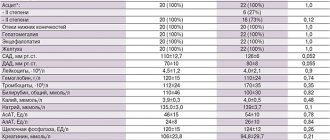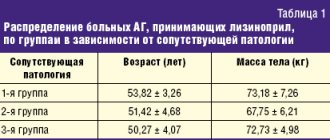Chronic arterial hypertension requires urgent drug treatment, so specialists try to select an antihypertensive drug for the patient that is suitable for daily normalization of blood pressure. The most popular drugs from the group of ACE inhibitors are Lisinopril and Enalapril, their action is aimed at inhibiting the production of angiotensin-converting enzyme. Thus, both drugs block the action of an enzyme that takes part in the biological processes that contribute to the narrowing of blood vessels. These drugs are similar in their mechanism of action, but they have some differences in composition and dosage regimen, so the question arises for hypertensive patients, which is better, Lisinopril or Enalapril?
Composition and form of release of medicines
The drug formula Enalapril was created at the end of the 20th century as one of the analogues of Captopril. The drug belongs to the second generation ACE inhibitors. The chemical formula of Lisinopril was created in 1975, and it began to be produced later by a Hungarian pharmacological company.
Available in the form of white tablets with a division in the middle, in the amount of 10 pieces in a blister.
Enalapril is a chemically modified form of the drug, which in the body, as a result of metabolism, is transformed directly into the active component. The main active substance in the medication is enalapril maleate, in concentrations of 5, 10, 20 mg.
The drug also contains additional components, such as:
- sugar;
- lactose monohydrate;
- cellulose;
- talc;
- magnesium stearate;
- sodium bicarbonate.
Additional components may vary depending on the manufacturer.
The chemical components of Lisinopril are not affected by metabolic processes in the body. Thus, the active substance in the drug is lisinopril, in the form of dihydrate at a concentration of 10 mg.
Available in the form of single-color tablets, with cut edges and division on one side
The medicine contains the following auxiliary components:
- lactose monohydrate;
- corn starch;
- magnesium stearate;
- methylene chloride;
- povidone.
The additional components remain unchanged, only their dosage changes depending on the concentration of the active substance.
Comparison of ease of use of Lisinopril and Enalapril
This includes dose selection taking into account various conditions and frequency of doses. At the same time, it is important not to forget about the release form of the drug; it is also important to take it into account when making an assessment.
The ease of use of Lisinopril is approximately the same as Enalapril. However, they are not convenient enough to use.
The drug ratings were compiled by experienced pharmacists who studied international research. The report is generated automatically.
Last update date: 2020-12-04 13:42:31
Differences in pharmacological properties
Enalapril has a vasoconstrictor effect, which reduces peripheral vascular resistance, reduces the load on the myocardium and stabilizes blood pressure.
Regular use of the medication produces the following effects on the body:
- elimination of spasm of arterial walls;
- normalization of systolic and diastolic pressure;
- reduces the load on the myocardium;
- restores blood circulation in the heart and kidney arteries;
- reduces the risk of progression of heart failure;
- produces a diuretic effect, thereby preventing fluid retention in the body;
- eliminates left ventricular hypotrophy;
- prevents the process of thrombosis.
The use of Lisinopril in the early rehabilitation period after an acute heart attack reduces the risk of death
The pharmacological properties of Lisinopril include direct inhibition of aldosterone production and an increase in the synthesis of prostaglandins. The drug has a similar effect on the body of a hypertensive patient as Enalapril, since all the effects are due to the effect on the renin-angiotensin-aldosterone system. However, there is a difference between drugs in the mechanism of evacuation from the body, since the drugs belong to different classes of ACE inhibitors. Thus, Enalapril is a lipophilic prodrug in which the elimination of breakdown products occurs mainly through the kidneys, and to a lesser extent, through the liver.
Lisinopril belongs to the hydrophilic group of medications that are not amenable to metabolic processes in the body. The active components are evacuated in unchanged form, mainly by the kidneys.
It follows from this that the distinguishing feature of Enalapril from Lisinopril is their distribution in the body after consuming the tablet. So Enalapril undergoes a process of biotransformation into the active metabolite - enalaprilat.
The transformation of the structural components of Enalapril occurs in the liver, which exposes it to additional functional load. Therefore, in hypertensive patients with liver dysfunction, a significant decrease in the conversion of active components may be observed, that is, a decrease in the therapeutic effectiveness of the drug.
Comparison of side effects of Lisinopril and Enalapril
Side effects or adverse events are any adverse medical event that occurs in a subject after administration of a drug.
Lisinopril has almost the same level of adverse events as Enalapril. They both have few side effects. This implies that the frequency of their occurrence is low, that is, the indicator of how many cases of an undesirable effect of treatment are possible and registered is low. The undesirable effect on the body, the strength of influence and the toxic effect of Lisinopril are similar to Enalapril: how quickly the body recovers after taking it and whether it recovers at all.
Which medicine is better according to the method of administration?
Before choosing the best antihypertensive drug, patients have a question: what is the difference between drugs that are similar in almost all respects? One of the significant differences between Lisinopril and Enalapril is the dosage of the active substance and the dosage regimen, which, although they have minor differences, do affect the therapeutic effect.
Due to its prolonged action, Enalapril is more effective when taken in the morning
The duration of the hypotensive effect of Enalapril is on average 18 hours. To maintain normal blood pressure, it is recommended to take the drug 2 times a day, regardless of meal times. The medicine has a long period of evacuation from the body, so it is prescribed once or twice a day. However, the drug has one main drawback: it enters the body in an inactive state, which means it requires activation of the active substance in the liver. The drug's chemicals can accumulate in fatty tissue, reducing its effectiveness in overweight patients. Therefore, patients with a history of hypertension and type 2 diabetes should take the pills with caution.
A stable hypotensive effect when taking Lisinopril is observed after 1-2 months, which should be taken into account when increasing the dose
Lisinopril compares favorably with its analogue, since the hydrophilic class of the drug is well suited for the treatment of arterial hypertension. The duration of action is 24 hours, providing mild stabilization of blood pressure. It is enough to take the tablets once a day.
During treatment with both drugs, the following recommendations should be followed:
- monitor blood pressure levels throughout the day;
- monitor indicators of the state of the circulatory and excretory systems using laboratory tests;
- monitor the functional state of the heart and kidneys;
- Do not increase the dose of the drug yourself;
- It is recommended to take the minimum doses that maintain the hypotensive effect;
- Do not combine products with drinking alcohol.
General description of Lisinopril
The antihypertensive drug Lisinopril contains lisinopril dihydrate. This is a long-acting inhibitor. Used to treat hypertension and prevent consequences. Its peculiarity is the possibility of use in patients with obesity.
Available in tablets of 5, 10 and 20 mg. Manufacturer – Avant, Ukraine.
The drug reduces the formation of angiotensin and suppresses aldosterone. Increases tolerance to physical activity, reduces blood pressure, dilates arteries, reduces preload in CHF.
Long-term use of the drug leads to a decrease in hypertrophy of the heart muscle and arteries. Treatment leads to improved blood circulation in ischemic disorders. Prolongs the life of patients with chronic heart failure.
It begins to act within an hour, maintaining the result for a day. The effect for hypertension is observed within 1-2 days from the start of administration. A stable result is observed after 4-8 weeks.
Research and effectiveness
Lisinopril is a well-studied ACE inhibitor, the mechanism of action of which is based on reducing angiotensin synthesis and suppressing the activity of the renin-angiotensin system.
In a comparative analysis of the effectiveness of Enalapril and Lisinopril, both drugs showed a persistent decrease in blood pressure, but the effect of the latter was more pronounced. Tolerability of drugs is no different. At the same time, Lisinopril acts for a longer time.
The risk of side effects from using the drug depends on the duration of treatment. The most common symptom is a dry cough, occurring in 4-18% of patients.
Lisinopril is the reference ACE inhibitor. Its high effectiveness has been proven in diseases such as arterial hypertension and diabetes. It can be widely used in the treatment of these diseases.
Source:
“The use of Lisinopril for arterial hypertension,” Difficult Patient, 2006.
Contraindications
Lisinopril is contraindicated if a hypersensitivity reaction to the components in the composition has previously been observed. The drug is not prescribed for narrowing of the aorta, cerebrovascular pathologies, or coronary artery disease.
Other contraindications to the use of the drug:
- hematopoietic disorders;
- connective tissue pathologies;
- hypoglycemia;
- narrowing of the renal artery;
- up to 18 years of age and in old age.
During pregnancy, Lisinopril is not prescribed, since there is no data on its toxic and mutagenic effects on the embryo. In case of treatment during lactation, breastfeeding is temporarily stopped.
Side effects
In rare cases, patients experience attacks of hypotension. There is a risk of arrhythmia, angina, dizziness, tachycardia. Some patients note increased fatigue, hand tremors, and decreased appetite. Possible taste disturbance.
Possible side effects from different systems and organs:
- CNS – lability, confusion;
- CVS - severe decrease in blood pressure, angina pectoris, rapid heartbeat;
- Gastrointestinal tract - dry mucous membranes, hepatitis, pancreatitis, dyspepsia;
- allergic manifestations - swelling of the lips, face, tongue, rash, fever;
- others – vasculitis, increased urea levels, asthenia.
In case of overdose, a pronounced decrease in blood pressure occurs. At the same time, dry mucous membranes, drowsiness, constipation, anxiety, and irritability are observed. When the dosage is increased with the development of undesirable symptoms, symptomatic therapy is carried out. Vasopressors are prescribed and blood pressure is monitored.
A strong decrease in blood pressure while taking ACE inhibitors is often associated with taking diuretics, which reduce circulating blood volume. This effect can also be caused by diarrhea, vomiting, and restriction in the diet of table salt.
In rare cases, there is a possibility of acute kidney failure, myalgia, and fever. During pregnancy, while taking the drug, there is a risk of kidney pathology in the unborn child.
Dosage
The initial dose of Lisinopril is 10 mg per day for 1 dose. If the effect is insufficient, the dose is increased to 20-80 mg/day. For CHF, treatment begins with 2.2 mg. The maintenance dose is 5-20 mg r/s.
If the water-electrolyte balance is disturbed, the dosage does not exceed 5 mg. For maximum effect, it is recommended to take the medicine at the same time every day.
Who is it suitable for?
Lisinopril is indicated for patients with different types of arterial hypertension. It is prescribed in the complex therapy of CHF.
Which drug is better in the treatment of hypertension?
Lisinopril has been used for the treatment of hypertension for many years, and at this time there is a lot of practical evidence proving the good effectiveness of the drug compared to other analogues.
In the treatment of arterial hypertension, both drugs showed good tolerance by the body.
A direct comparison of the therapeutic effectiveness of Lisinopril and Enalapril was carried out by monitoring blood pressure levels in patients undergoing antihypertensive treatment. For qualitative control, it was customary to use the target blood pressure level (140/90 mm Hg), the dosage of the active substance was selected until the stated indicators were achieved. Both medications reduced blood pressure to an optimal level, but the therapeutic effect of taking Lisinopril was more pronounced.
As a result of the study, it was revealed that with the same dosage and dosage regimen, Lisinopril has a longer duration of action.
Thus, both drugs have shown in practice high effectiveness and safety in the treatment of hypertension. The most advantageous feature of Lisinopril is its broader indications for use, so it can be prescribed to patients with obesity, viral hepatitis, and a history of acute heart attack.
Comparison of addiction between Lisinopril and Enalapril
Like safety, addiction also involves many factors that must be considered when evaluating a drug.
So, the totality of the values of such parameters as “syndrome o” in Lisinopril is quite similar to the similar values in Enalapril. Withdrawal syndrome is a pathological condition that occurs after the cessation of intake of addictive or dependent substances into the body. And resistance is understood as initial immunity to a drug; in this it differs from addiction, when immunity to a drug develops over a certain period of time. The presence of resistance can only be stated if an attempt has been made to increase the dose of the drug to the maximum possible. At the same time, Lisinopril has a fairly low incidence of “syndrome”, just like Enalapril.
Indications for use
Enalapril and Lisinopril belong to the same group of drugs. They are prescribed to reduce high blood pressure in the following situations:
- essential hypertension of any severity;
- arterial hypertension due to kidney disease;
- chronic heart failure.
According to the instructions for use, Enalapril is recommended for patients with heart failure at any stage of development. The drug slows the progression of the disease, reduces the frequency of hospitalizations due to complications and increases patient survival.
Lisinopril is recommended in the early stages of myocardial infarction. It is prescribed in the first 24 hours to patients with stable hemodynamics to prevent disruption of the left ventricle and the development of heart failure. According to experts, lisinopril is the only ACE inhibitor that saves lives during myocardial infarction.





